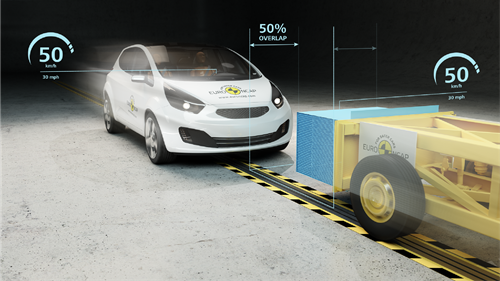Mobile Progressive Deformable Barrier

Frontal crashes are responsible for more deaths and serious injuries than any other accident type. A typical scenario is a head-on collision between two oncoming cars at moderately high speeds. In most collisions of this type, only a part of the vehicle front width structure is involved, i.e. the two colliding vehicles are offset. Accident data suggest that moderate offsets are most common in Europe.
FRONTAL IMPACTS ARE RESPONSIBLE FOR MORE DEATHS AND SERIOUS INJURIES THAN ANY OTHER ACCIDENT TYPE
In the full-scale MPDB test, the test car is driven at 50 km/h and with 50 percent overlap into a deformable barrier mounted on an oncoming 1400 kg trolley, also travelling at 50 km/h. The barrier represents the front end of another vehicle, getting progressively stiffer the more it is deformed. The test replicates a crash between the test vehicle and a typical mid-size family car. Two frontal impact dummies representing the average male are seated in the front and child dummies are placed in child restraints in the rear seats. The dummies, vehicle and trolley are instrumented to show the forces and decelerations to which the occupants would be subjected. Especially the driver dummy in this test, THOR-50M,is a highly sophisticated and sensitive test device, developed to accurately estimate the risk of head, neck, chest and abdominal injury.
Several aspects of a car’s safety are assessed in this test. To protect the test car’s occupants, crash forces have to be efficiently directed to parts of the car where the energy can be efficiently and safely absorbed. The front crumple zone must collapse in a controlled way, leaving the passenger compartment as undeformed as possible while, at the same time, not exposing the occupants to dangerously high levels of deceleration. Rearward movement of the steering wheel and the pedals must be limited if serious injuries are to be avoided. Moreover, the way in which the trolley decelerates in the impact, and the damage inflicted by the test vehicle to the deformable barrier, indicate how efficiently the two partners have interacted. A vehicle which leads to extremely high trolley decelerations or which causes very severe localised deformation is said to exhibit poor ‘compatibility’. In the real world, such vehicles may not absorb their own energy as efficiently as they should and pose a threat to other road-users.
 Introduced in 2020.
Introduced in 2020.